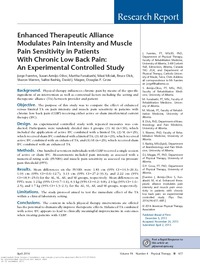Mostrar el registro sencillo de la publicación
Enhanced therapeutic alliance modulates pain intensity and muscle pain sensitivity in patients with chronic low back pain: An experimental controlled study
| dc.contributor.author | Fuentes-Contreras, Jorge | |
| dc.contributor.author | Armijo-Olivo, Susan | |
| dc.contributor.author | Funabashi, Martha | |
| dc.contributor.author | Miciak, Maxi | |
| dc.contributor.author | Dick, Bruce | |
| dc.contributor.author | Warren, Sharon | |
| dc.contributor.author | Rashiq, Saifee | |
| dc.contributor.author | Magee, David J. | |
| dc.contributor.author | Gross, Douglas P. | |
| dc.date.accessioned | 2017-11-03T14:04:07Z | |
| dc.date.available | 2017-11-03T14:04:07Z | |
| dc.date.issued | 2014 | |
| dc.identifier.uri | http://repositorio.ucm.cl/handle/ucm/1078 | |
| dc.description.abstract | Background: Physical therapy influences chronic pain by means of the specific ingredient of an intervention as well as contextual factors including the setting and therapeutic alliance (TA) between provider and patient. Objective: The purpose of this study was to compare the effect of enhanced versus limited TA on pain intensity and muscle pain sensitivity in patients with chronic low back pain (CLBP) receiving either active or sham interferential current therapy (IFC). Design: An experimental controlled study with repeated measures was conducted. Participants were randomly divided into 4 groups: (1) AL (n=30), which included the application of active IFC combined with a limited TA; (2) SL (n=29), which received sham IFC combined with a limited TA; (3) AE (n=29), which received active IFC combined with an enhanced TA; and (4) SE (n=29), which received sham IFC combined with an enhanced TA. Methods: One hundred seventeen individuals with CLBP received a single session of active or sham IFC. Measurements included pain intensity as assessed with a numerical rating scale (PI-NRS) and muscle pain sensitivity as assessed via pressure pain threshold (PPT). Results: Mean differences on the PI-NRS were 1.83 cm (95% CI=14.3–20.3), 1.03 cm (95% CI=6.6–12.7), 3.13 cm (95% CI=27.2–33.3), and 2.22 cm (95% CI=18.9–25.0) for the AL, SL, AE, and SE groups, respectively. Mean differences on PPTs were 1.2 kg (95% CI=0.7–1.6), 0.3 kg (95% CI=0.2–0.8), 2.0 kg (95% CI=1.6–2.5), and 1.7 kg (95% CI=1.3–2.1), for the AL, SL, AE, and SE groups, respectively. Limitations: The study protocol aimed to test the immediate effect of the TA within a clinical laboratory setting. Conclusions: The context in which physical therapy interventions are offered has the potential to dramatically improve therapeutic effects. Enhanced TA combined with active IFC appears to lead to clinically meaningful improvements in outcomes when treating patients with CLBP. | es_CL |
| dc.language.iso | en | es_CL |
| dc.rights | Atribución-NoComercial-SinDerivadas 3.0 Chile | * |
| dc.rights.uri | http://creativecommons.org/licenses/by-nc-nd/3.0/cl/ | * |
| dc.source | Physical Therapy, 94(4), 477–489 | es_CL |
| dc.subject | Electrotherapy | es_CL |
| dc.subject | Injuries and conditions: low back | es_CL |
| dc.subject | Patient/client-related instruction | es_CL |
| dc.subject | Pain | es_CL |
| dc.subject | Professional-patient relations | es_CL |
| dc.subject | Psychosocial: other | es_CL |
| dc.title | Enhanced therapeutic alliance modulates pain intensity and muscle pain sensitivity in patients with chronic low back pain: An experimental controlled study | es_CL |
| dc.type | Article | es_CL |
| dc.ucm.facultad | Facultad de Ciencias de la Salud | es_CL |
| dc.ucm.indexacion | Scopus | es_CL |
| dc.ucm.indexacion | Isi | es_CL |
| dc.ucm.doi | doi.org/10.2522/ptj.20130118 | es_CL |



